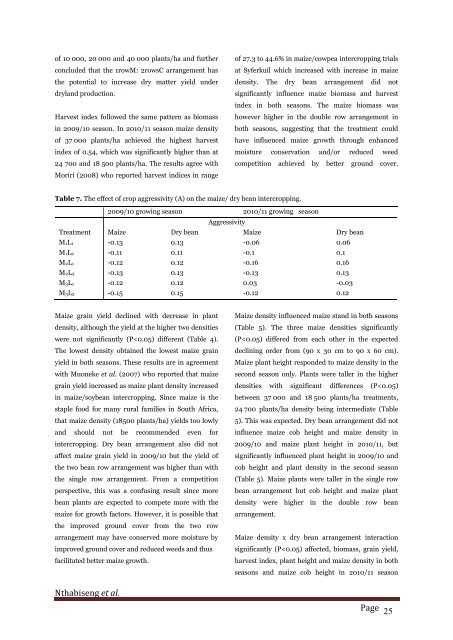Response of a maize or dry bean intercrop to maize density and dry bean arrangement under rainfed conditions
Abstract An experiment was conducted under dryland conditions at the University of Limpopo experimental farm, Syferkuil, in Capricorn district in 2009/10 and 2010/11 growing seasons to determine the effect of maize density and dry bean arrangement on performance of a maize/bean intercrop. The trial was a 2 x 3 factorial arrangement consisting of ten treatments: three maize densities (18500, 24700 and 37000 plants/ha), and two dry bean arrangements (single and double row arrangement). Sole treatments were added to enable comparison of the performance of sole crops and intercrops. Maize density of 18500 plant/ha achieved significantly (P<0.05) lower maize yield than 24700 and 37000 plants/ha in both seasons. Intercropping with double rows of dry bean resulted in higher maize yield in both seasons. The Combination of 37000 plants/ha with double arrangement achieved highest maize yield in both seasons. Maize density of 24700 plants/ha produced higher dry bean yield than 18500 and 37000 plants/ha. The double row bean arrangement resulted in higher dry bean grain yield in both seasons. The combination of 24700 plants/ha and double row arrangement attained the highest dry bean yield in both seasons. Intercropping achieved LER values greater that one. Maize density of 37000 plants/ha with double row of dry bean gave the highest LER value of 1.76 in 2009/10 season while in 2010/11 maize density of 18500 plants/ha with double row of dry bean arrangement achieved the highest LER value of 1.92. Maize/bean combination of 37000 plants/ha maize with double row arrangement of dry bean is recommended.
Abstract
An experiment was conducted under dryland conditions at the University of Limpopo experimental farm, Syferkuil, in Capricorn district in 2009/10 and 2010/11 growing seasons to determine the effect of maize density and dry bean arrangement on performance of a maize/bean intercrop. The trial was a 2 x 3 factorial arrangement consisting of ten treatments: three maize densities (18500, 24700 and 37000 plants/ha), and two dry bean arrangements (single and double row arrangement). Sole treatments were added to enable comparison of the performance of sole crops and intercrops. Maize density of 18500 plant/ha achieved significantly (P<0.05) lower maize yield than 24700 and 37000 plants/ha in both seasons. Intercropping with double rows of dry bean resulted in higher maize yield in both seasons. The Combination of 37000 plants/ha with double arrangement achieved highest maize yield in both seasons. Maize density of 24700 plants/ha produced higher dry bean yield
than 18500 and 37000 plants/ha. The double row bean arrangement resulted in higher dry bean grain yield in
both seasons. The combination of 24700 plants/ha and double row arrangement attained the highest dry bean
yield in both seasons. Intercropping achieved LER values greater that one. Maize density of 37000 plants/ha with
double row of dry bean gave the highest LER value of 1.76 in 2009/10 season while in 2010/11 maize density of
18500 plants/ha with double row of dry bean arrangement achieved the highest LER value of 1.92. Maize/bean
combination of 37000 plants/ha maize with double row arrangement of dry bean is recommended.
Create successful ePaper yourself
Turn your PDF publications into a flip-book with our unique Google optimized e-Paper software.
<strong>of</strong> 10 000, 20 000 <strong>and</strong> 40 000 plants/ha <strong>and</strong> further<br />
concluded that the 1rowM: 2rowsC <strong>arrangement</strong> has<br />
the potential <strong>to</strong> increase <strong>dry</strong> matter yield <strong>under</strong><br />
<strong>dry</strong>l<strong>and</strong> production.<br />
Harvest index followed the same pattern as biomass<br />
in 2009/10 season. In 2010/11 season <strong>maize</strong> <strong>density</strong><br />
<strong>of</strong> 37 000 plants/ha achieved the highest harvest<br />
index <strong>of</strong> 0.54, which was significantly higher than at<br />
24 700 <strong>and</strong> 18 500 plants/ha. The results agree with<br />
M<strong>or</strong>iri (2008) who rep<strong>or</strong>ted harvest indices in range<br />
<strong>of</strong> 27.3 <strong>to</strong> 44.6% in <strong>maize</strong>/cowpea <strong>intercrop</strong>ping trials<br />
at Syferkuil which increased with increase in <strong>maize</strong><br />
<strong>density</strong>. The <strong>dry</strong> <strong>bean</strong> <strong>arrangement</strong> did not<br />
significantly influence <strong>maize</strong> biomass <strong>and</strong> harvest<br />
index in both seasons. The <strong>maize</strong> biomass was<br />
however higher in the double row <strong>arrangement</strong> in<br />
both seasons, suggesting that the treatment could<br />
have influenced <strong>maize</strong> growth through enhanced<br />
moisture conservation <strong>and</strong>/<strong>or</strong> reduced weed<br />
competition achieved by better ground cover.<br />
Table 7. The effect <strong>of</strong> crop aggressivity (A) on the <strong>maize</strong>/ <strong>dry</strong> <strong>bean</strong> <strong>intercrop</strong>ping.<br />
2009/10 growing season 2010/11 growing season<br />
Aggressivity<br />
Treatment Maize Dry <strong>bean</strong> Maize Dry <strong>bean</strong><br />
M1L1 -0.13 0.13 -0.06 0.06<br />
M1L2 -0.11 0.11 -0.1 0.1<br />
M2L1 -0.12 0.12 -0.16 0.16<br />
M2L2 -0.13 0.13 -0.13 0.13<br />
M3L1 -0.12 0.12 0.03 -0.03<br />
M3L2 -0.15 0.15 -0.12 0.12<br />
Maize grain yield declined with decrease in plant<br />
<strong>density</strong>, although the yield at the higher two densities<br />
were not significantly (P





![Review on: impact of seed rates and method of sowing on yield and yield related traits of Teff [Eragrostis teff (Zucc.) Trotter] | IJAAR @yumpu](https://documents.yumpu.com/000/066/025/853/c0a2f1eefa2ed71422e741fbc2b37a5fd6200cb1/6b7767675149533469736965546e4c6a4e57325054773d3d/4f6e6531383245617a537a49397878747846574858513d3d.jpg?AWSAccessKeyId=AKIAICNEWSPSEKTJ5M3Q&Expires=1716814800&Signature=yMric74KppGX2RsUg02nJmwvX%2Bw%3D)












